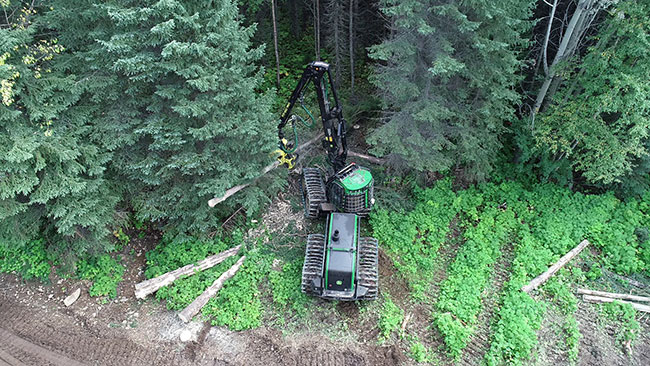
Industry News
News
Harvesting
FPInnovations releases operational manual for commercial thinning in BC
March 18, 2022 By FPInnovations
 A John Deere 1270E Harvester cutting a new trail. Photo courtesy FPInnovations.
A John Deere 1270E Harvester cutting a new trail. Photo courtesy FPInnovations. In British Columbia, the large-scale application of commercial thinning (CT) has become increasingly important over the last few years. CT is beneficial as a stand-tending operation as well as a way to provide fibre to the interior of the province to mitigate the shortage caused by large-scale disturbances such as bark beetle epidemics and fire. To that effect, FPInnovations recently published The Operational Manual for Commercial Thinning in British Columbia.
Value of CT
CT is becoming more important in B.C. every year. Joint committees involving specialists from government, industry, academia, and research organizations are working together to find the best methods for application of CT in the province.
Ongoing and future efforts seek to further inform the applicability of CT practices in B.C. and the improvement of Provincial CT Guidance, through a transparent and scientific approach to trial design, data collection and analysis. Clear research objectives are being set to guide questions and fill knowledge gaps in this process. Significant work is also conducted in Alberta by FPInnovations’ industrial members.
CT increases the volume of fibre produced by stands as well as their value. In addition, timeliness of fibre availability for sawmills in the interior regions of B.C. is of paramount importance for communities. In the long term and for larger management units, CT improves the distribution of stands by age class and also allows better planning of forest resources.
FPInnovations’ Operational Manual for Commercial Thinning
The operational manual for CT presents FPInnovations’ experience on the application of CT, presents methods for selection of CT candidate stands, defines prescriptions and assess the economic operability of harvest blocks and supervise operations, as well as to determine the productivity and cost of machines used. The manual can be used by forest planners, field supervisors and machine operators in different phases of CT implementation.
The operational manual also introduces the partial cutting simulator (PCSim), a model for defining prescriptions and assessing the economics of CT operations using traditional or enhanced (LiDAR-based) forest inventory data.
The production of the manual was financially supported by Natural Resources Canada.
For more information, please contact Mihai Pavel (mihai.pavel@fpinnovations.ca), senior researcher at FPInnovations.
[Read CFI’s in-depth feature on FPInnovations project to explore commercial thinning in B.C.]
Print this page